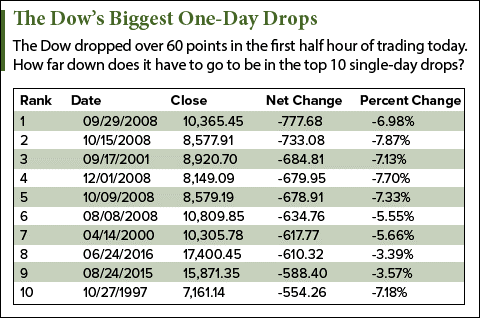The Dow hit 20,000 last Wednesday and has stayed above that mark until today (Tuesday). This morning, the Dow had a sudden drop of over 60 points in the first 30 minutes of trading. Fears of a tumbling market now have investors asking "what is the largest daily point loss of the Dow Jones Industrial Average?"
The biggest single-day drop in the Dow came in 2008 after all of the major investment banks announced they needed a bailout when the housing bubble burst.
On Sept. 29, 2008, the Dow saw its largest single-day drop of 777.68 points (6.98%). The drop came after a two-week run on banks, along with Congress stalling on the TARP bailout plan.
We have to wait and see if today will continue on the downward trend started this morning. In the meantime, here's a look at the top 10 biggest single-day drops of the DJIA.

The most recent addition to the largest one-day drops for the Dow occurred on June 24, 2016. Brexit was the cause of this drop. The markets panicked when the British voted to exit the European Union (EU) and venture into the unknown. That day, the Dow fell more than 610 points.
But that was a case of the markets overreacting to surprising news. By July 1, 2016, the markets had recovered to the pre-Brexit level.
When the Dow drops, your portfolio can take a hit. But that doesn't mean investors need to be caught off guard. Here's how you preserve your wealth when the markets start falling...
Protecting Your Investments When the Dow Drops
[mmpazkzone name="in-story" network="9794" site="307044" id="137008" type="4"]
Protecting your investments from a potential downturn or stock market crash is important for every investor. Our gurus recommend two long-term strategies and one short-term strategy for protecting your portfolio.
The short-term strategy that Money Morning Capital Wave Strategist Shah Gilani recommends is ProShares Short S&P 500 (NYSE Arca: SH).
Don't Miss: Know Exactly What to Buy, What to Sell, and How to Protect Your Money in 2017
The reason this is a short-term strategy is that the exchange-traded fund (ETF) moves in the opposite direction of the S&P 500. That means that as the index drops, the value of the ETF rises. This can help offset your portfolio losses.
Once the S&P 500 starts to rise, you need to sell your ProShares Short S&P 500 position. As the index rises, the ETF will drop in value. You will want to capture gains before the index rises.
The first long-term strategy to protect your portfolio in a market downturn is to invest in gold. Money Morning Global Credit Strategist Michael Lewitt suggests investing 10% to 20% of your investment portfolio in gold.
Since gold bars are not a practical purchase for most, Lewitt recommends investing in gold-backed ETFs. The ETF that he recommends is the SPDR Gold Trust (NYSE Arca: GLD).
The last portfolio recommendation for a market downturn is to invest in what Money Morning Chief Investment Strategist Keith Fitz-Gerald calls "Unstoppable Trends." These trends are going to continue no matter what happens in the market. They include technology, health, energy, scarcity, demographics, and war.
For a full breakdown of how to protect your investments in a downturn, check out our guide to investing for a stock market crash.


